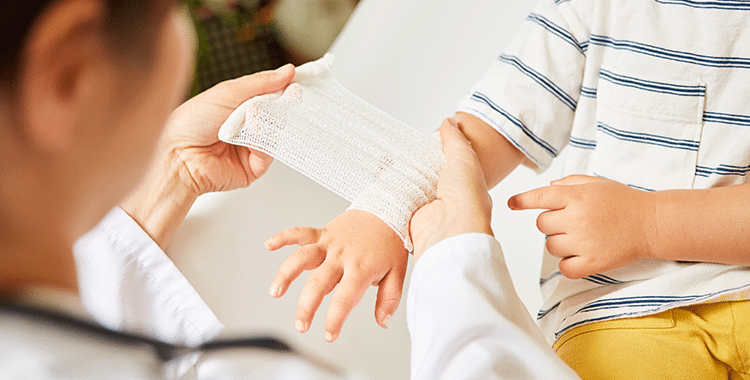The theme of this year’s Mental Health Awareness Week (13 to 19 May) is Movement: moving more for our mental health. Did you know that children who spend more time engaged in adventurous physical play have fewer symptoms of anxiety and depression? Here’s how to incorporate age-appropriate, adventurous play into your outdoor environment.
What is adventurous play?
Adventurous, or risky, play is child-led play that invokes feelings of excitement, thrill, and fear, often in the context of age-appropriate risk-taking. Riding bikes fast downhill, climbing trees, jumping from high surfaces, and playing out of adult sight are good examples. The benefits of engaging in this form of play have long been acknowledged. However, researchers at the University of Exeter have recently discovered that risky play helps build children’s resilience and protects mental health.
Children who spend more time playing outside have fewer ‘internalising problems’, namely anxiety and depression, the 2021 parental study found. Helen Dodd, professor of child psychology at Exeter University who is undertaking a seven-year research project looking at children’s adventurous play as a mechanism to reduce anxiety, says that the findings highlight the possibility of being able to ‘protect children’s mental health by ensuring they have plentiful opportunities for adventurous play’.
Let the children play.
The latest NHS Digital data launched ahead of Mental Health Awareness Week reveals that one in five children experience mental health difficulties. With emotional disorders on the rise, there is no time like the present to get children outdoors experimenting with risky play scenarios in a safe, non-threatening way.
Exploring risk and challenge in a supportive environment is linked to increased emotional well-being, resilience and better mental health. Small mistakes and minor accidents can also offer protection against future failure’s adverse effects.
When children are engaged in thrilling, exciting experiences exposed to a small amount of fear and uncertainty, such as sliding fast down a steep slope or balancing on a wobbly bridge, they learn to hold their nerve when feeling on the edge of control. Experiencing physiological sensations, such as hearts racing, palms sweating or butterflies in their stomachs in a safe environment, also helps develop children’s resilience and the ability to cope physically and emotionally with unexpected events.
Here are some ideas on incorporating age-appropriate, adventurous play into your outdoor environment. Risk assessments should always be performed:
Forest School: Children are encouraged to push the boundaries by embracing challenges at Forest School. They might end up covered in mud, picking up worms, scaling tall trees, igniting fires using flint and steel, or swinging from ropes suspended in trees (secured by experts).
While balancing on a slippery log, children fall over and try again, engaging in trial and error, which fosters confidence and resilience.
Supervised tool use is also expected at Forest School sessions. As children bang nails into a tree stump with a hammer, saw wood or carve with a knife, they build up their ability to evaluate risks in different scenarios, which will serve them well.
Large play equipment: Structures that allow children to climb and jump off or play at heights offer opportunities for adventure and are essential for children’s physical development.
Large, freestanding playground equipment can be expensive to install. However, because of their open-ended nature, loose parts allow children to set the challenge at the right level for them. For example, old tyres offer versatile options where risk levels can be tailored to match children’s abilities and preferences. They can be stacked for climbing and leaping, or a child can lie inside one while rolled along.
Obstacle courses can be created with crates, planks of wood, tyres, and cable drums. Old pallets are a great, free way to add height. Children love to climb up them or just sit on top of them. You can also let children practice their balance and coordination on wooden sleepers and tree stumps.
Playing at high speed: Many children seek out adventurous play that involves moving at speed, hanging upside down, sliding headfirst down a slide or rolling and spinning. They love to run down hills at uncontrolled speed, slide down mud banks, cycle at high speed, and sledge down steep hills. These actions involve risk and may occasionally lead to a collision, but the benefits outweigh the risks in most situations.
Hidden spaces: Children love nooks and crannies where they can hide away and feel like they are a million miles away from adult view. Willow structures are significant for this. Or children can make their own dens out of pallets, which are great because you can see through them to supervise their play. Provide plenty of giant pegs camouflage material for spontaneous den play.
A positive approach
In supporting children’s desire for risk and challenge, practitioners need to consider their own attitudes towards risk so they can make judgements that enable rather than restrict learning and safety.
One could argue that over-emphasis on safety is the most significant risk of all. It risks raising a generation of children who recklessly seek thrills without the confidence and ability to navigate them safely. Alternatively, children who are over-cautious and lack the desire to be adventurous, imaginative, and innovative in their thinking.

Nicole
Content Creator




